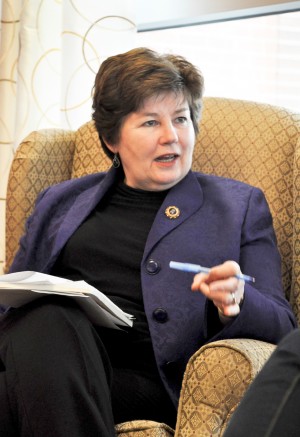
Dawn Russell says residence renewal is on her list of goals for next year, which includes a new lounge for students.
She says it’s been obvious to her, even before off-campus students brought it to her attention, that there needed to be a special space for off-campus students. The studies show that the retention and success of students is greater for students in residence but the tradition is also for upper-year students to go off campus. Russell says this social connection helps them.
“If you have off-campus students from the area and they are just coming to class or being in the study hall or eating, but then they otherwise feel that they should go home, that’s not a very vibrant environment for them, and so having a space where off-campus students can meet and just ‘bug out’ really between class … they need a space where they can do it.”
A new lounge for off-campus students will be ready next fall on the first floor of James Dunn Hall where the residence life offices used to be. The Sir James Dunn Foundation gave a donation for the lounge and drawings are already done to show what it will look like.
President Russell says between book launches and international awards, St. Thomas University has a lot of to be proud of this year, but the budget will be the biggest challenge for next year.
Russell says her toughest hurdle this year has been dealing with the provincial government concerning the university’s budget. STU has an inequitably low provincial grant per student at 84 per cent of the provincial average.
She says there has been some progress in terms of the government understanding the university’s concerns, but it will be a concern next year to maintain the quality of the education while keeping a balanced budget. STU is looking at a shortfall of $600,000.
“One of the first things we accomplished, and I’m not sure is obvious to students, but was part of a implementation of a governance structure review last year, was that we were able to put in a new system. We had a dean of faculty and a dean of research, and the structure we have now is a dean of humanities and a dean of social science to help strengthen the whole academic structure.”
Russell says it’s important that St. Thomas completed its strategic planning process this year after consultations with all members of the university. It has been approved by the senate and the board of governors. They came to a consensus on a five-year plan for STU.
“It includes our overall aspiration of excellence and to be a premier liberal arts university, which we’re certainly capable of.”
STU is also looking for a chair in citizenship and human rights.
“Over the next few years we hope to strengthen that area because we have courses across the university in that area but we need to make sure we have strong leadership to guide the students in that area.”
Russell wants to expand opportunities for applied learning and extracurricular learning activities, two things she touched on in her installment speech.
“We have a search ongoing in fine arts for someone in musical theatre and we’re going to have a limited-term appointment this year because we’re not sure yet that we’ve seen the right candidate.”
While some people question the effects of the new major in communications and public policy, which is seen as applied learning, Russell says the major is a step in the right direction.
“The liberal arts have been a very practical education foundation in my life. If you mean it’s an applied learning, like a trade, that’s not the goal of the liberal arts and thinking broadly about public policy is already something that our faculty are doing across disciplines.”
It is still uncertain where the office for The Frank McKenna Centre for Communications and Public Policy will be, as additional staff have made office availability an issue.
Communications director Jeffrey Carleton says since he’s been at STU for eight years, the number one issue year after year is office space.
Carleton says there will be a focus on student enrolment and student retention and accomplishing the goals in the strategic plan and then working them into programs and activities for students.
“The tendency at this time of year is to sit back and look at what happened from September onwards and you just get blown away if you sit down and look at all the people who were here, all the guest lecturers, all the conferences, all the symposiums, two Prime Ministers in one week. Not many universities can pull that off.”

